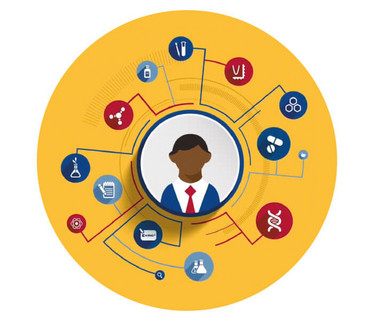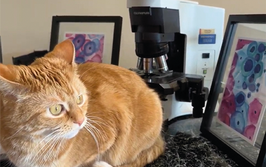Young but Powerful
Penn Medicine’s Center for Personalized Diagnostics is on a mission to improve patient care using the power of genomics

I was in college, planning to become either a veterinarian or a professional musician, when I first encountered cloning. My mind was blown by the incredible promise of this new technology – and right away, I decided to become a physician-scientist. From then on, I became totally focused on research – specializing in pathology, choosing the most research-oriented residency I could find, and then working for the National Institutes of Health (NIH) on a problem that provided me with many years of scientific inspiration: how DNA rearrangements in developing lymphocytes occur normally, and how aberrant rearrangements cause lymphoid malignancies. That inspiration carried me through the next two decades of my scientific career, until, in 2011, I moved to the University of Pennsylvania.
I was invited to Penn for two reasons: to chair the Department of Pathology and Laboratory Medicine there, and to start up Penn’s next generation sequencing (NGS) diagnostics by setting up a new Center for Personalized Diagnostics (CPD). The center, a joint effort between my department and the Abramson Cancer Center (ACC), just turned three years old and has rendered diagnoses on almost 5,000 clinical cases. It’s also inspired us to move deeper into personalized medicine – and the first step in that direction is Penn’s new Center for Precision Medicine. Its main role is to help us design, test and implement precision medicine-based clinical care pathways.
Pushing for precision
At its most basic, “precision medicine” means giving the right therapy to an individual patient at the right time. Many would argue that physicians have been practicing individualized medicine since the beginning of the profession, and I agree. Doctors have always used the best tools available to diagnose and treat their patients. What has changed is our level of accuracy – so I think the term “precision medicine” is apt.
My experiences as a medical student 30 years ago planted the seeds of my work in precision medicine. At that time, we weren’t doing a great job with patients who had advanced cancer. I spent a few weeks with a group that was trying a new therapy for a very difficult disease. The results were so dismal that it was clear we couldn’t treat cancer effectively without knowing much more about its biology. That realization drove me into pathology, and I’ve worked on the mechanisms underlying cancer ever since. In 2006, my lab genetically engineered mice that rapidly developed lymphomas with incredible levels of genomic instability. We disabled some of the regulatory controls associated with antigen receptor gene assembly in developing lymphocytes, and every animal developed lymphoma within a few weeks. To understand the mechanism, we needed to characterize the genomic alterations in the tumor cells – so we began to develop NGS technologies. As the results came in, I grew convinced that these technologies would soon unlock many of cancer’s mysteries.
As we were conducting our research, others were doing the same, and a group of scientists working to sequence various kinds of cancers began to publish. Perhaps their most striking finding, and one that was repeated over and over again, is that cancers with the same histopathological features – such as adenocarcinoma of the lung – could have many different kinds of genetic lesions. This suggested that a particular morphologically defined cancer was not one, but many different diseases, and that they could be treated individually. I realized that the ability to make these diagnoses routinely could be a game changer – and that was my key motivation to set up the Center for Personalized Diagnostics.

The nature of the beast
Getting the right diagnosis has always been critical in medicine. But with the tools we have now, especially recent advances in genomic diagnostics, we can be incredibly precise. Instead of treating, for example, adenocarcinoma of the lung as a single disease with an unknown cause, we can now recognize many different subtypes of this disorder, each bearing its own molecular signature. Importantly, we can often relate that signature to a physiologically important alteration of a gene that causes cancer (a “driver mutation”). Even better, in many cases we now have specific drugs that target the altered pathways. We can identify the targets (precision diagnostics) and hit them with “magic bullets” (targeted therapeutics), causing minimal collateral damage to normal tissues. In fact, physicians can even engineer a patient’s own immune system to specifically attack their tumor cells – an approach that has recently cured some leukemias.
At this point, precision medicine is most advanced in the field of cancer care, but its concepts will be important in a wide variety of other disorders. After all, the principles are the same for every disease – find out exactly what’s wrong, and then provide carefully tailored tools to fix it.
Bumps in the road
Three challenges in particular have been on my mind recently:
- One is applying existing knowledge to devise and institute clinical care pathways based on principles of precision medicine. This will require substantial changes in the way we deliver care for particular disorders, and we will need to collect large amounts of data along the way to continually evaluate whether or not we’re really improving upon the standard of care.
- At the other end of the pipeline, devising new diagnostics, biomarkers, and therapeutics will require collection of many kinds of data from individual patients (known as “deep phenotyping”). This is expensive and cumbersome, and integrating data from disparate sources can be difficult. Harmonizing data coming from different institutions is equally difficult, so we’ll need to develop interoperability standards for easier collaboration. These areas are a focus of the President’s new Precision Medicine Initiative, so the future looks promising!
- Finally, we must be careful not to overpromise. The technologies are exciting, and some of the promise has already been realized. I think precision medicine as a field is on pretty firm footing. But it’s easy for enthusiasm to get out of control, and there is an awful lot of commercial activity in this field. I remember the excitement (and the flurry of tech startups) that surrounded the completion of the Human Genome Project. At the time, many people thought cures for cancer were right around the corner. Needless to say, there was some disappointment. A decade and a half later, these dreams are beginning to come true.
Creating a center
To sum it all up in a sentence: creating the center was exciting, difficult, at times scary, and it turned out to be the most fun and rewarding activity of my professional life.
My initial vision was for the CPD to have a tripartite mission: clinical care, research, and education. Given the pressing need for molecular cancer diagnostics, our first clinical care priority was to develop NGS-based diagnostics for use in tumor samples. Given the financial constraints and the expectation that the laboratory would need to rapidly become financially self-sufficient, we wanted to focus on clinically actionable results, and we wanted to deploy quickly. That’s why we opted to deploy just two relatively small panels: one for solid tumors and a custom leukemia panel.
We were able to build and validate the tests, which are based on the Illumina MiSeq platform and supported by a custom bioinformatics workflow, quite rapidly – the clinical lab opened just a year and a half after we conceived of the project. Along the way, we also developed a curriculum in genomic pathology for residents and fellows, as well as offerings for the medical students. The research mission has lagged behind because of our initial focus on clinical development, but now that the clinical lab is functioning well, we are turning our attention back to science.
The lab was designed to be financially self-sustaining after startup, which served as a constraint (and a guideline) for test development. We developed targeted panels for use in somatic cancer testing because those tests provide clinically useful results and, ultimately, allow us to be reimbursed. Even more critical than money, though, was forging collaborations between departments. From the very beginning, the CPD was a collaboration between my department and the ACC. We had many meetings with clinicians and other key stakeholders in which we worked out our strategy – the scope and nature of the tests to be offered, reimbursement paradigms, the reporting of results, and so on. The process was very time-consuming, and sometimes it took a lot of effort to get everyone on the same page, but it paid off. Our partnerships with clinicians have kept most of our testing in-house, spurred a number of research efforts, and allowed us to provide more clinically applicable tests. Clinicians have definitely had a say in every part of the process, and that turns out to be very empowering.
Today, our major focus is still on somatic cancer diagnostics, but we are beginning to think about branching out into other areas. In our first year, we returned about 1,000 results. We’ve grown considerably, and are now offering more tests, including both substantially larger panels and small panels designed to allow testing of very small specimens, including cytopathology specimens. We’ll soon hit our 5,000th patient sample – and this year, we will more than double our initial annual volume. It’s been incredibly gratifying to see our entire team pull together and accomplish something I’m sure many people thought we couldn’t. Penn is a very collaborative institution, and that has really worked in our favor, letting us offer cancer patients new treatment options and broaden the realm of possibility for treating difficult diseases.
Penn Medicine’s Center for Personalized Diagnostics
Established: 2012.
Located: Hospital of the University of Pennsylvania, Philadelphia, Pennsylvania, USA.
Website: www1.pennmedicine.org/personalized-diagnostics/
A joint initiative between Penn Medicine’s Department of Pathology and Laboratory Medicine and the Abramson Cancer Center, the Center for Personalized Diagnostics’ current goal is to analyze the genetic characteristics of individual cancers. With that information, patients can make important decisions faster and receive more targeted treatment. The center aims for turnaround times under two weeks, including review by subspecialized pathologists, and also contributes to translational and clinical research.
The CPD currently employs four technologists, three faculty, two genetic counsellors, two bioinformaticians, one clinical fellow and one research and development scientist – and the numbers are growing rapidly. The center also hosts a clinical fellowship.
Advice to others
Precision medicine is a big topic. I’m sure that the only reason many members of the public have heard about precision medicine is because of the announcement made at the President’s 2015 State of the Union address, which was focused mainly on building a large research cohort. Many of our peer institutions are developing research-focused precision medicine projects. In our newly launched Penn Center for Precision Medicine, we chose instead to focus on developing ways to move ideas, processes, or technologies derived from precision medicine into patient care, and to measure the outcomes of these interventions (see tp.txp.to/0316/penn-cent for more information).
Based on my interactions with people in the community, I think we have a long way to go in educating people about the benefits of current precision medicine approaches to cancer, which include genomic testing (see our short video about cancer testing at http://tp.txp.to/inside-cpd-video). That’s the message I would like to emphasize to the public. I recently met a woman who had been diagnosed with metastatic lung cancer several years previously. She was advised to say goodbye to her young children. And yet, for several years now, she has been on a series of targeted therapies that have kept her disease stable. She has been able to watch her children grow up. Precision medicine may be in its infancy, but even today, it has tremendous power to help individual patients.
Young but Powerful By David Roth
Field of Genes By James Broach
David Roth is Director of the Penn Center for Precision Medicine and Simon Flexner Professor and Chair of Pathology and Laboratory Medicine at the University of Pennsylvania, Philadelphia, USA.




















